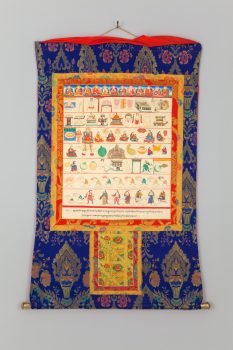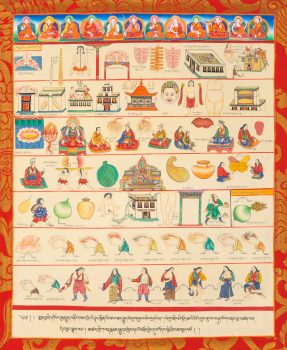Hua Khar
Chentsa, Amdo region, Northeastern Tibet (Jianzha, Qinghai Province, China)
1995-1996


Hua Khar
Chentsa, Amdo region, Northeastern Tibet (Jianzha, Qinghai Province, China)
1995-1996


This painting depicts measurements of and metaphors about the body used to help students and practitioners memorize portions of medical texts. It compares parts of the body to components of a Tibetan house (“the twenty-four ribs are like well-laid rafters”) as well as organs to members of a royal family and government (“the heart is like a king seated on his throne”) and to common household items (“the stomach is like a cooking pot”). This modern painting is a copy of a work from the important seventeenth-century set of medical paintings.
While the primary religious goal for followers of Buddhism is enlightenment, many of the practices also serve secular goals related to daily life, including ethical conduct and cultivating well-being.
Teachings and precepts that offer practical and experiential guidance. In Buddhism instruction is primarily an oral tradition and is often targeted to the specific needs or disposition of a student or disciple.
The passing down of authentic Buddhist teachings from a teacher to a disciple or student, often in the form of a text in a ritualistic context.
Today, Tibetans primarily inhabit the Tibetan Plateau, situated between the Himalayan mountain range and the Indian subcontinent to the west, Chinese cultural regions to the east, and Mongolian cultural regions to the northeast. During the 7th to 9th century, Tibetan rulers expanded their empire across Central Asia, and established Buddhism as the state religion.
Get the latest news and stories from the Rubin, plus occasional information on how to support our work.